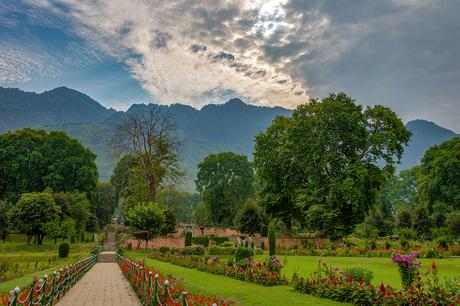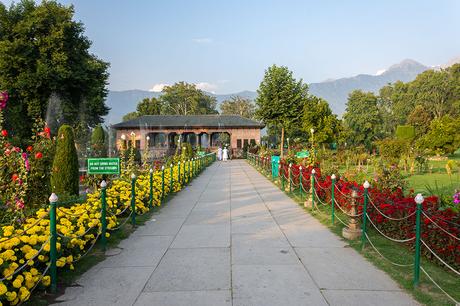Near Srinagar’s renowned Dal Lake is the 12-terraced garden known as the Nishat Bagh. After Shalimar Bagh, it is Kashmir’s largest Mughal garden. It is also often known as the “Garden of Bliss.” Asif Khan, Nur Jahan’s older brother, planned and constructed Nishat Bagh in 1633.
Although the Persian gardens served as inspiration for Nishat Bagh’s layout, Kashmir Valley’s particular topography and water features were used in the landscaping instead.The garden is divided into two parts by a stream of still water, and each level of the garden is designated by a high embankment that is home to a unique array of colourful flowers. With the Zabarwan Mountains serving as its backdrop, you can see the Dal Lake in all its glory.
Architecture of Nishat Bagh
The Nishant Bagh’s layout and design, like those of all the Mughal Gardens, are heavily influenced by Persian architecture. It features a lovely water channel running through the centre, which enhances the garden’s romantic appeal. Nishat Bagh is renowned for its 12 terraces, each of which is decked with lovely flowers like roses and lilies and symbolises a different zodiac sign. Due to its Architecture a lot of people visit Nishat Bagh during Kashmir Tour Package from Guwahati and from all over the country
Twelve Gardens of Nishat Bagh
Nishat Bagh’s twelve gardens correspond to its twelve immaculate terraces. The 12 zodiac signs are represented by this collection of 12 Persian-style patios. A public garden and a private garden make up Nishat Bagh. Each terrace features a variety of roses and lilies in addition to being surrounded by many Cyprus and China trees. Here, each terrace offers distinctive qualities like:
Terrace 1 –
a water storage facility connected to the garden’s primary inflow.
Terrace 2 –
This patio has more than five fountains and an entrance.
Terrace 3 –
This terrace features a distinctive design with a two-tiered construction and five tiny slots on the front and sides.
Terrace 4 –
hosts a pool and a water channel.
Terrace 5 –
Has a squared enclosure with five fountains and a seating area with a stone surface.
Terrace 6 and Terrace 7 –
sites that have a very different general design and two levels each with five fountains.
Terrace 8 –
possesses a waterway.
Terrace 9 –
Has a pool with nine fountains and an eight-sided seating area.
Terrace 10 –
Has two stairways that bracket a water channel that contains fountains.
Terrace 11 –
The 25 fountains on this patio.
Terrace 12 –
This space, which is also known as the Zenana chamber, features a protected front walling adorned with decorative arches. In addition, this terrace has two parallel octagonal towers, a garden enclosed by a double-layered construction, and lovely paintings.
History of Nishat Bagh

The Nishat Bagh was created and constructed in 1633 by Asif Khan, Nur Jahan older brother. In 1633, Kashmir was home to the reigning emperor of Mughal India, Shah Jahan, who paid a visit to this garden. He wanted the Nishat Garden to be given to him by Asif Khan because he was so moved by its divine beauty. The emperor cut off the water supply to the garden after Asif Khan failed to do so.
Asif Khan was devastated and distraught, losing interest in everything else. One of his staff had the audacity to switch on the water supply from Shalimar Bagh one day while he was relaxing in the garden beneath a tree. Khan learned of this, he quickly ordered that it be switched off for fear of Shah Jean’s furious response to the violation of his orders.
Jahan did not, however, actually become irritated by the circumstance. Instead, he thanked the servant for his faithful dedication to his lord and then gave Asif Khan complete restoration rights for the water supply to the garden.
How to Reach Nishat Bagh
There are Best 3 ways to reach Kashmir valley which are given below:
By Air
There are numerous carriers available for domestic travellers to use to get to Srinagar from various significant Indian cities. The airport in Srinagar has good connections with Mumbai, Chandigarh, Delhi, and Shimla. Travelers flying into Srinagar from other nations can do so via Delhi. They can take use of convenient transportation options after landing in Srinagar to visit Nishat Bagh.
By Bus
Private coaches, regular bus routes, and taxis provide excellent access between Jammu Tavi and Srinagar. National Highway 1A, which connects Srinagar to the rest of India, travels through lovely valleys, extensive tunnels, and gorgeous mountain ranges. During the summer, Leh and Kargil are accessible from Srinagar.
You can also visit Nishat Bagh with Swastik Holiday Mumbai Travel Agents.
By Rail
The closest rail station to Srinagar is in Udhampur, which is 60 kilometres north of Jammu. With excellent connections to the majority of India’s major cities and towns, Jammu Tavi Railway Station is located 293 kilometres from Srinagar. Travelers can easily and comfortably book train trips to Jammu from significant cities such as Chennai, Trivandrum, Kolkata, Mumbai, Bengaluru, Pune, and others.
After reaching Jammu, travellers can take a conventional bus or hire a taxi to make the last 12-hour trip to srinagar.
Places to visit around Nishat Bagh

There are numerous locations in Srinagar to see besides Nishat Bagh that can make the Kashmir trip memorable. Srinagar is home to a number of well-known tourist destinations in kashmir that are must-see locations, from serene lakes to venerated mosques and historic temples.
Near Nishat Garden in Srinagar are some of the following well-known locations:
- Dal Lake,
- Tulip Garden,
- Shalimar Bagh,
- Shankaracharya Temple,
- Lal Bazar,
- Anchar Lake,
- Hazratbal Shrine,
- Pari Mahal, and
- Hari Parbat.

